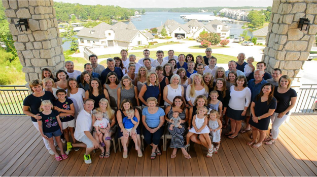Aligning Your External Mission with Your Family’s Values

Why did your family start giving? Did you want to achieve a specific impact on an issue close to your hearts or did you want to bring your family together to pass on specific values from generation to generation? In most cases, it is a little bit – or a lot – of each.
Simon Sinek offers a very clear case for understanding a family’s ‘why’ in his seminal TED talk ‘How great leaders inspire action’ and his best-selling book Start with Why.
In our day-to-day work in family philanthropy, we often worry about ‘what’ we do and don’t often pause to consider the ‘why.’ We spend a lot of time crafting and stewarding our external mission statements to describe the impact we’d like to make in the world with partners and the people inside the issues we hope to face.
But perhaps we should also spend some concerted time thinking about the why — asking questions like Why is our family involved in philanthropy? What impact do we hope to see in our families through this work?
Some families approach these questions by creating their own internal mission statements — and by finding opportunities to steward both their internal and external missions.
In essence, they are deliberately working to connect why they are doing this work with what they are hoping to accomplish.
The Tracy Family Foundation offers a wonderful case study for how to make this connection.
The foundation, created in 1997 by the 12 children of Dorothy and Robert Tracy, deliberately works to connect its external and internal missions — and creates measurements to ensure it is working toward achieving each.
Like most family foundations, it has a well-defined external mission.
The Tracy Family Foundation’s external mission statement prioritizes investing in education, youth and families, leadership, and economic development in a 10-county region in West Central Illinois and in the communities the extended family calls home.
The family tracks an impressive array of metrics in each category utilizing public data and outcomes from their grant partners and collaborations. Goals are set for elements such as enrollment, achievement and leadership including percentage of students in various grades who score in the top quartile of standardized tests, percentage of students enrolling in post-secondary education immediately following graduation, and number of educators who complete the School Leadership Academy.
Through an annual grantmaking program of nearly $4 million, the family and its partners make a measurable impact in their communities.

But what sets the 90-member, four-generation Tracy family apart is its overt attention to its internal mission. Together, the family has crafted meaningful vision and goal statements to underscore their commitment.
Tracy Family Vision Statement:
The Foundation will build a legacy of leadership and generosity among Tracy Family members as they engage with unity and passion in the work of the Foundation. Through the Foundation, a grateful and philanthropic spirit will be cultivated among all Tracy generations present and future. The Tracy family will actively engage in building improved, sustainable change in Brown County, the surrounding region, and in their own communities.
Tracy Family Goal:
Family members will actively participate in opportunities provided by the Foundation. Such engagement in the Foundation will result in family members who are knowledgeable about the nonprofit sector and family members who are inspired to give back of their time, talent, and/or treasures to nonprofit organizations
The Foundation provides many avenues for family members to become involved including seats on the board, 10 committees, a matching grant program, next generation grant program, and volunteer incentives providing support in exchange for a gift of time.
With the same level of discipline used for its external mission, the family tracks its progress toward its internal mission through three main themes: philanthropic spirit, leadership, and volunteerism.
Example measures include:
Philanthropic Spirit:
- Percentage of each generation participating in the matching grant program
- Participation in the annual family meeting in the Ozarks
- Percentage of family members who have created their own donor advised fund or private foundation.
Leadership:
- Percentage of each generation who have served on the Foundation Board or Next Generation Board and number of family members serving on committees.
Volunteerism:
- Number of family members who volunteer at organized family outreach activities.

The Tracy family further supports the internal mission with an annual survey to gauge interest and ensure all family members provide feedback and ideas for improvements.
Families start giving together in many different ways. Some begin with volunteering their time at a local organization, others start by raising money through an annual 5K run, others create donor advised funds or foundations, and some simply begin with a conversation at the kitchen table before making year end gifts.
Regardless of how you began, consider focusing on why you decided to give together in the first place. Take a page out of the Tracy Family playbook and spend deliberate time and effort crafting, communicating, stewarding, and living your internal mission.
The effort you invest in inspiring and educating future leaders in your family will strengthen your ability to be a good partner in making a meaningful impact in our world.
To learn more about the Tracy Family Foundation visit tracyfoundation.org.
Douglas Bitonti Stewart is an NCFP Fellow and executive director of the Max M. & Marjorie S. Fisher Foundation in Detroit. The Fisher Foundation’s external mission is to strengthen and empower children and families in need. Its internal mission is to strengthen family ties through philanthropy and service. Visit mmfisher.org to learn more about the foundation.
